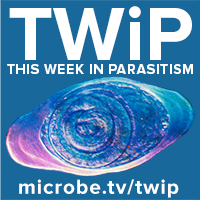Christina returns to the TWiP trifecta to solve the case of the Beachgoer with Red Lines on Her foot, and an experimental malaria vaccine based on the junctional region of the circumsporozoite protein displayed on a virus-like particle.
Hosts: Vincent Racaniello, Dickson Despommier, and Daniel Griffin
Guest: Christina Naula
Click arrow to play
Download TWiP #195 (49 MB .mp3, 81 minutes)
Subscribe (free): iTunes, Google Podcasts, RSS, email
Links for this episode
- PWB on Facebook, Instagram, Twitter
- VLP-based malaria vaccine (Cell)
- Promise of a malaria vaccine (Ann Rev Micro)
- Hero: Maria Mota
- Letters read on TWiP 195
Become a patron of TWiP
Case Study for TWiP 195
Gentleman in 60s, does not have permanent home, comes in with skin issues. Pruritis all over. Wearing heavy coat, unwashed polyester shirt. 1 cm diameter patches, erythematous, areas where open from scratching. Cover much of torso. Solve case by examining his clothes.
Send your case diagnosis, questions and comments to [email protected]
Music by Ronald Jenkees


Hello to everyone, thank you for taking my answer.
I am a biologist, and I studied animal parasitology in school. I also have experience having grown up on a farm in Rosarito, Baja California, Mexico and have learned firsthand about both animal and plant parasites.
The fact that the inspection of the patient did not give the cause or culprit of the symptoms, and the heavy coat did, leads me to think of a parasite like bed bugs( Cimex lectularius), which do not actually live on their hosts, but on their bedding, or in this case clothing. The size of the red skin marks of 1 cm is within the range of possible reactions of the skin when bitten by this insect. The itching goes well with this diagnosis, including the persistent itching as to cause breakage of the skin and scabbing.
Greetings Gabriel
Hello all,
Prof. Despommier, with respect, the river in Cleveland that caught fire was not the Vermillion River, but the Cuyahoga River. I would put a pronunciation guide, but that seems to split Clevelanders linguistically as much as the river does geographically. Depending on the source you look at, the name roughly translates to “Crooked River” blended from various local indigenous languages.
The fire in June 1969, caused by heavy pollution, is commonly credited as a factor leading to the passing to the Clean Water Act of 1972 and the development of the EPA.
From the Randy Newman song “Burn on”:
“Now the Lord can make you tumble
And the Lord can make you turn
And the Lord can make you overflow
But the Lord can’t make you burn”
Yep, for that, we just need neglect, corruption, and a lack of regulation.
Hello,
I am a long-time listener of This Week in Virology and This Week in Evolution, but I am a recent listener of TWiP. I have a background in Evolutionary Biology and I teach Anatomy and Physiology. I am definitely by no means an expert on parasitism, but the last clue automatically made me think bed bugs. I remember NYC had a major problem with them in apartments, etc. years ago, so I assume, despite eradication measures taken indoors, the insects have had no problem surviving in the wild, i.e. the streets. Thank you all for everything that you do to keep us scientists and science enthusiasts entertained!
Best regards,
Kyle Boudreau